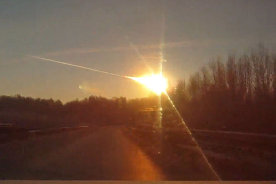An Asteroid, A Meteor, One Day and a Lot of Questions
What a coincidence. Only a few hours before a uncomfortably close call with asteroid 2012 DA14, which will pass within the orbit of geostationary satellites, a much smaller, and very unwelcome visitor from space shot across the Russian sky before detonating in a mid-air explosion which blew out windows and injured hundreds in the Chelyabink region, approximately 900 miles east of Moscow.
Although unrelated, and coming in from very different orbits, the juxtaposition of the two events are enough to leave people wondering whether or not the world is doing enough to first identify, and then develop methods for mitigating future impacts which could bring devastation on a biblical scale.
The first step is learning a great deal more about the nature and distribution of earth crossing asteroids, which is the primary goal of the privately funded B612 foundation and its Sentinel mission. The fact that such a mission is privately strongly suggests that the people most familiar with the subject, do not believe it is getting adequate from the world’s space agencies. In the United States, where the EPA is often eager to regulate, and frequently disrupt entire industries, with imposed costs of billion of dollars over what are negligible and very debatable health risks, the Tier IV diesel engine certification program comes to mind, a very real threat to the planetary ecosphere somehow gets scant attention.
Even if we cannot deflect or detour asteroids at the moment, the work to be done in identifying their presence can go a long way to developing early warning systems for much smaller meteors. Reportedly most of today’s injuries came from broken glass, as the pressure wave from the exploding meteor blew in thousands of windows. Much like with tsunami or tornado warning systems, the ability to predict when and where small strikes occur could allow ample time to move into safer areas, even if it is only away from outer rooms.
NASA is in fact in the process of searching for and cataloging as many as earth crossing asteroids as it can, and even has a sample return mission to a small asteroid, Osiris-Rex, scheduled for later this decade, but it may be a matter of priority. With NASA’s Science Mission Directorate already facing substantial budget cuts and facing more under sequestrati0n, it may take substantially more than today’s events to come to the realization that although the chances are small in any given year, the risk is very real. And Bruce Willis might not always be around.


